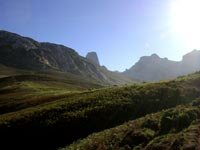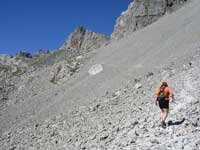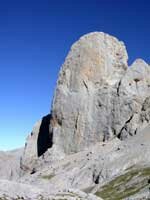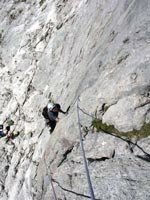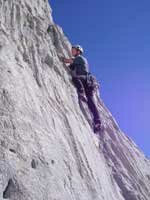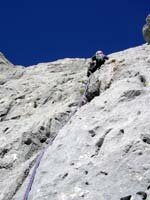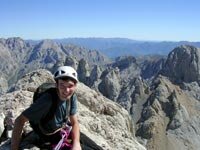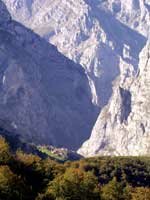Naranjo de Bulnes

So, after a two year wait, we get to the Picos de Europa. Most of the holiday is to be spent mountain biking with our wives but we have “permission” to get a big route in. The obvious hill of choice is El Naranjo de Bulnes or El Picu as it is also known. Steve has borrowed my guidebook and reckons that Amistad con el Diablo is the route to do: slabby with only one hard pitch and that around HVS in difficulty.
Given the guidebook times for the walk-ins I am thinking of stopping at Sotres in the car and walking in; doing the route; and walking out in the day. However, our host reckons that we should walk in the day before and stop at the hut at Vega Urriellu, then do the route as getting to the hill will take several hours. So going with local knowledge we make plans to ride up in the cable car at Fuente De and walk across the Horcados Rojos col before dropping down to the hut. We will walk out to Sotres as this is all downhill rather than climbing back over the col. Our wives have offered to drive round to meet us.
Not having climbed here before I am unsure as to what to take: the guide mentions that Hexes are useful so all those go into the rack, as do most of the cams. Eventually we settle on the gear - I still think that it is too much but as we aren't carrying bivvy gear, Steve is thinking of taking a bigger rack. Still, it all goes into our sacks along with extra clothing, food and water.
Mike, our host, has booked places at the hut for us - we only have to get there for 1900hrs to ensure that we get an evening meal. So it is, that at midday we join the hordes of overweight tourists at the foot of El Cable and wait to pay our six Euros for the trip to the plateau. Our wives are accompanying us on the walk as far as the col before they head back to the cable car and descent.
An hour later and we are on our way, the tiny cabin hauling us 600m to the plateau. Debouching from the cabin we thread our way through the tourists clinging to the walls in shock at the sudden exposure beneath their feet and head to the hills. A couple of minutes and the hordes are left behind, the more adventurous wandering along the initial four wheel drive track.
From the col we head North-west along an old mining track (Lead was mined in these there hills) until a suitable outcrop provides shade for a spot of lunch. The outcrop has an old mine adit along with a crystal clear pool at its entrance.
Lunch is followed by the only real ascent of the walk up a set of dusty zig-zags. From the top of these the Cabane Veronica is visible. This is a gun turret from an old American aircraft carrier! It sleeps six apparently. Our path does not visit this but bears off right a few hundred metres before it and climbs over easy rock slabs to the col.
The vista changes dramatically: ahead the ground drops away into one of the large Hous that litter the plateau; beyond, El Naranjo pokes its head into the sky; in the distance the northern valleys are cloud filled then the Bay of Biscay extends to the horizon. We loiter, taking photos until it is time for us to go on. Cath and Ang have the cable car to catch; we have to get to the hut.
The descent begins with a climb to gain the top of a set of shallow rakes down the slabs. These are equipped with a wire for a handrail. It is not that the scrambling is difficult, more that the slabs are covered in grit and scree making a sure footing awkward to achieve. The handrail continues for longer than expected and we are nearly at the scree before its security is left. We are now in the Hou Los Boches and the landscape is distinctly lunar, there is little vegetation - all is limestone or scree of the same. Littered around the floor of the Hou are small sink-holes looking like the disappearing sand in an egg-timer.
The path crosses the floor of the Hou to rise a little before skirting over rock slabs around the next Hou. This is even stranger in appearance than the previous hollow. A short rock step leads to a col where the West Wall of El Naranjo is suddenly revealed rising behind the hut.
Another five minutes and we are at our destination with plenty of time to confirm that we want an evening meal. Check-in reveals a slight flaw in our preparations: we should have brought identity documents of some form. This being Spain however, he checks us in anyway. We now have around 3 hours of light to use so we decide to head up the approach to check it out.
On the way we nearly walk into a “rebeco” or the local version of the chamois. It wasn't too bothered with our presence so after taking a photo or two we scrambled up to the area beneath the east face. There were several teams still making their way back after a days’ climbing so the area wasn’t as quiet as I would have expected, in fact it looked positively busy! As the day began to fade we jogged back to the hut with strange looks from the locals - they obviously aren’t used to seeing people scree running - or in fact running at this sort of altitude. (Note that the continental version of fell running only really consists of the uphill part - crazy downhills are not part of the game!)
The West face of El Naranjo is turning its characteristic orange in the evening sunlight. The hut is in shadow though and the temperature is dropping so we head inside for the evening meal. This is the usual four course Spanish meal and is very filling. Armed with a beer we head outside to watch the stars appear. Eventually though it is too cool and we retire for the night.
The morning comes around soon enough and we have breakfast and pay up (47 Euros for the two of us) before following the depressingly large number of teams heading around to the South and East of the peak. Fortunately most appear to be walkers - at least there is no-one on our intended route and there is only one other party on the East face anyway.
Having geared up there is only one thing to do - climb! I head off on the first easy pitch, seating a nut I knock my finger on the rock. Ouch! This stuff is sharp! Bleeding profusely I continue to the stance having run out nearly 50m of rope on what looked like 30m max. Steve arrives and surveys my still bleeding finger. Taking the gear, he sets off on the first real pitch, the way marked by “AD” scratched on the rock.
Uncharacteristically, he is nervous and slow, fixing protection at every opportunity. The climbing is mainly on canalizos - a sort of pseudo crack or channel formed by runoff of rainwater - but neither of us have climbed on these before so it is all new. Sometimes you can get a jam or pinch the rib between two canalizos, at other times you can only lay-away off a rounded edge. Slowly he gains height, checking each canalizo for a way forward until he is nearly level with the belay, but several metres to one side. Again what looks like a 30m pitch is nearer to 50m. Having gone wrong he has to reverse for a few moves until he can step left and then up to the chains.
Eventually, it is my turn and I arrive at the stance festooned in the gear from the pitch. “I’m not happy with the climbing” Steve announces “either you lead or we bail out”. After a moments’ thought I reckon we bail out and do the ordinary route so that at least we get to the top. A couple of abseils later and we are back on the ground and heading to the sacks to take on more water.
The normal route (well its more often climbed Direct version) starts in the centre of the South face which lies above an area of broken slabs. Plodding up these it is obvious that we will have to wait for a team which is on the first pitch. By the time we have geared up however the leader has run both the first two pitches together and the second is ready to go. It turns out they have 60m ropes which are only just long enough for this. With 50m ropes we will have to pitch it.
My lead, and it’s the crux of the route, the guidebook stating that the ability to climb canalizos is an asset. A couple of awkward moves and I am at the foot of the crux, a large Hexcentric fits perfectly for protection; a good jam leads to an awkward, polished layaway move and I am soon at the belay chains. Steve follows without problem.
On the second pitch, Steve’s nervousness shows again and it is some time before he reaches the belay. Most of this pitch is out of sight of the belay so I am unaware of what he is doing, only that it is taking time. Something is getting to him, this is most unlike Steve, in fact in my dotage I was relying on him doing the technical bits. The pitch is OK if a little blind in places. The next pitch is mine and is easy and soon I am at the third belay point.
The fourth pitch again takes time but there is a definite tricky section just before the easing. I wonder if we took the wrong set of canalizos. There is also the matter of stonefall from the parties above. The climbing eases now but I find myself pulling over a steepening with only a single runner 20m away, I am definitely off route. The earlier party are on the descent and indicate that I should be further to my right - a lot further! I eventually belay by a block and bring up Steve.
The climbing is easy now and Steve wanders up to belay in a groove. I follow and lead through to reach the summit ridge just as the rope runs out. Steve gets to the top and looks down the West face: “Oh, my giddy aunt!”I sit astride the ridge and bring up Steve. “Oh, my giddy aunt!” he cries as he looks over the other side and down the West Face. It turns out that this is the first time that he has been on a multipitch climb for over a year - hence the nervousness.
With an eye on the time we begin the descent - Steve going first, putting the occasional runner in, me following. We get to the correct belay at the point where I had gone wrong - I had been about 20m too far to the left. The abseils go without problem and we are able to link the last two pitches into one abseil, just reaching the ground on rope stretch.
We scramble back down to the sacks and attempt to rehydrate, being a south facing route we have been in the sun all day. Soon it is time to go and we shuffle off down the approach path. Steve decides to go back to the hut to get some water from the spring there. I decide to begin heading down the path to Sotres and let Steve catch up. The path drops steeply at first, zig-zagging down the scree and boulders, eventually the angle eases up and it begins to weave in and out of the side valleys. After a short rise the path passes through a notch and emerges onto the high meadows. I sit and wait for Steve in the afternoon sun.
Eventually he arrives and I grab some water off him. There is a refuge about two kilometres away where we should be able to get a beer or water. As we approach the refuge I see two figures coming up the path that look suspiciously like our wives. So it proves. The refuge is shut but they have brought some water. The pace is more gentle now and in another hour or so we reach the car in the valley.
